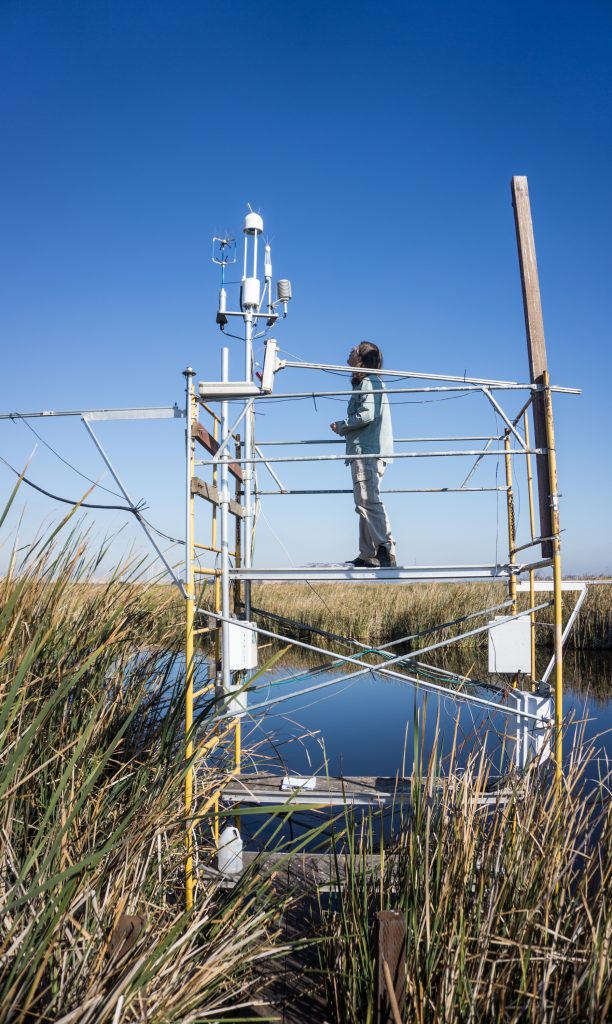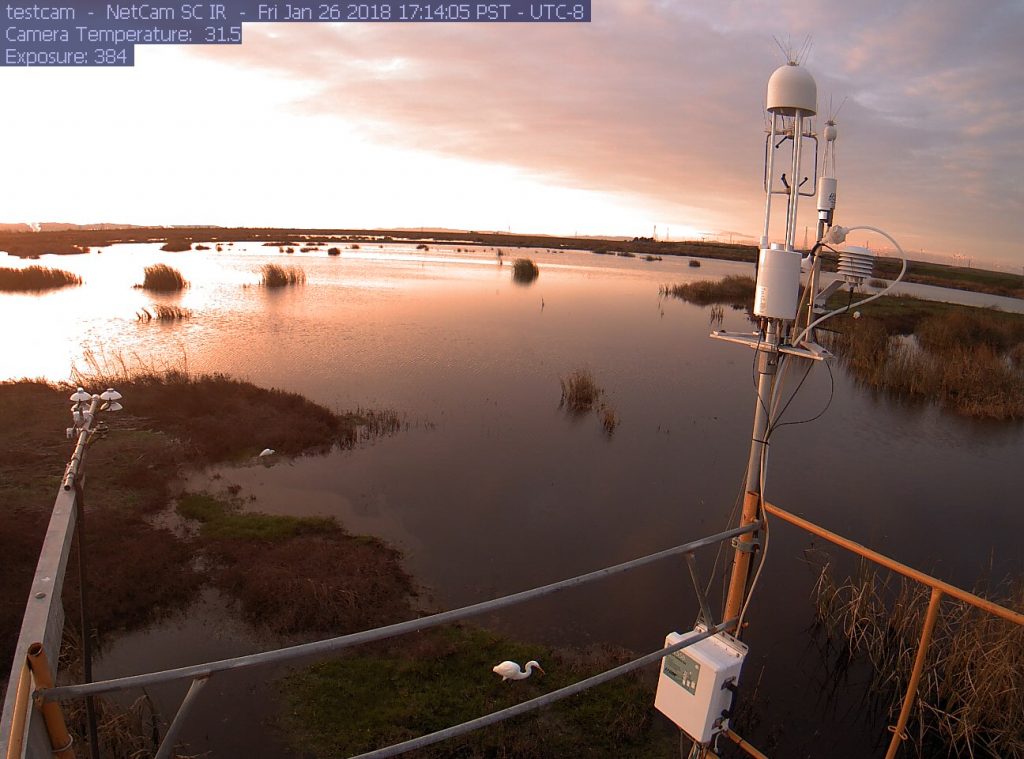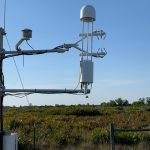From a dry vantage point on Twitchell Island, the deck of a cargo ship skims by, above a fragile levee that holds back the mighty San Joaquin River. A few centuries ago, standing in this same spot, we would have been covered in ten or twenty feet of peat, the residue from millennia of accumulating plant matter and bacterial corpses. Today Twitchell Island more closely resembles a bowl, ringed by levee walls, and largely emptied of its carbon-rich peat soil by over a century of drained agriculture. This is also true of the other Delta ‘islands’ that sit among the braided channels of the Sacramento and San Joaquin Rivers where, in some places, more than 8 meters of peat soil has been lost.
Our project in the Delta aims to understand if restored freshwater wetlands could help refill these subsided islands with soil, shore up California’s water infrastructure, and sequester carbon in the process. Our team, made up of California Department of Water Resource engineers, farmers, and UC Berkeley’s Biometeorology (Baldocchi) and Ecosystem Ecology (Silver) Labs, is envisioning a new Delta in which carbon is sucked out of the atmosphere by vegetation, and eventually buried in peat soils.

Standing dead biomass (thatch) is mixed within the new green stems of the canopy at a 5 year-old restored wetland (US-Tw4). PC: Kyle Hemes
A massive wetland restoration experiment is underway here. The formerly-drained agricultural peatlands have been gradually transformed, expanding out from a 7.5 acre experimental tract on Twitchell Island in 1997 (US-Tw1) to a future target of more than 3,500 acres of managed wetlands created as part of California’s Eco Restore program. Instead of peat being oxidized into the atmosphere, restored wetlands like ours on Twitchell and Sherman Islands are now trapping organic matter. Being submerged, the soil is slow to decompose and holds the bright green emergent marsh plants in place. With every year, new soil and plant residues slowly accumulate and centimeter by centimeter, this subsided island is refilling with dark and pungent peat soil.
After more than two decades of eddy covariance measurements, we are starting to understand the carbon exchange dynamics of these restored wetlands. Owing to their long growing seasons, warm temperatures, and abundant access to water, these wetlands are among the most productive globally, removing relatively large amounts of carbon dioxide from the atmosphere. But ‘there is no free lunch’, as Dennis Baldocchi, one of the site PIs, likes to remind us. A portion of the freshly added and old peat carbon gets consumed by methanogens and emitted into the atmosphere as methane.

Baldocchi Lab manager Joe Verfaillie inspects the sensor cluster on the tower at US-Myb which was restored in 2010-2011. Photo: Kyle Hemes
Our network employs eight open-path methane gas analyzers in an effort to understand the tradeoffs between carbon sequestered and methane released across a suite of land uses in the Delta. A recent synthesis shows that methane is critical to the story – only after a century does the climatic effect of the cumulative carbon dioxide removal outweigh the increase in methane’s potent global warming potential. Our work also aims to understand the complex non-linear drivers of methane evolution. Recent evidence suggests soil biogeochemistry, including redox cycling of iron, periodic water table drawdowns, and spatial structure all play a role in governing methane exchange. By better understanding the balance of emitted methane and sequestered carbon dioxide, we hope to inform management of these restored wetlands as a natural climate solution, while also creating habitat and securing California’s water system.=
Doctoral candidate Kyle S Hemes (UC Berkeley) adapted this post from a full-length article published in Earth Island Journal (2017) for the AmeriFlux Year of Methane.
Related Articles
Chamberlain, S.D., Anthony, T.L., Silver, W.L., Eichelmann, E., Hemes, K.S., Oikawa, P.Y., Sturtevant, C., Szutu, D.J., Verfaillie, J.G., Baldocchi, D.D., 2018. Soil properties and sediment accretion modulate methane fluxes from restored wetlands. Glob. Chang. Biol. 24, 4107–4121. https://doi.org/10.1111/gcb.14124
Matthes, J.H., Sturtevant, C., Verfaillie, J.G., Knox, S.H., Baldocchi, D.D., 2014. Parsing the variability in CH4 flux at a spatially heterogeneous wetland : Integrating multiple eddy covariance towers with high-resolution flux. J. Geophys. Res. Biogeosciences. https://doi.org/10.1002/2014JG002642
Hemes, K.S., Chamberlain, S.D., Eichelmann, E., Knox, S.H., Baldocchi, D.D., 2018. A Biogeochemical Compromise: The High Methane Cost of Sequestering Carbon in Restored Wetlands. Geophys. Res. Lett. https://doi.org/10.1029/2018GL077747
Hemes, K.S., Chamberlain, S.D., Eichelmann, E., Anthony, T., Valach, A., Kasak, K., Szutu, D., Verfaillie, J., Silver, W.L., Baldocchi, D.D., 2019. Assessing the carbon and climate benefit of restoring degraded agricultural peat soils to managed wetlands. Agric. For. Meteorol. 268, 202–214. https://doi.org/10.1016/j.agrformet.2019.01.017
Sturtevant, C., Ruddell, B.L., Knox, S.H., Verfaillie, J.G., Matthes, J.H., Oikawa, P.Y., Baldocchi, D.D., 2016. Identifying scale-emergent, nonlinear, asynchronous processes of wetland methane exchange. J. Geophys. Res. Biogeosciences 121, 188–204. https://doi.org/10.1002/2015JG003054






No Comments
Be the first to start a conversation